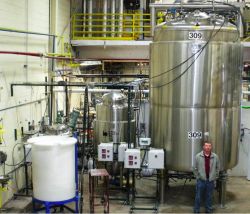ZeaChem released the results of its recent fermentation results of acetic acid, used in the conversion of biomass to biofuels. According to the company, the results demonstrated successful process scaling to a level that is 10,000 time greater than the standard scale used in lab tests. Fermentation units were scaled from 0.5 liter to 5,000 liters. Acetogens, which are naturally occurring, are highly robust and unlike yeast, produce no carbon dioxide during the fermentation process.
The company has been collaborating with Golden Colorado-based Hazen Research on the tests. Hazen constructed and hosted the initial front-end process unit and provided the infrastructure and operational support. The initial test exceeded ZeaChem’s time goals for achieving the concentration level, greater than 50 grams of acetic acid per liter in less than 100 hours, as well as exceeded commercial acceptable acetic concentration levels.
“ZeaChem has met and exceeded its concentration and rate fermentation targets,” said Jim Imbler, president and chief executive officer of ZeaChem. “We now have sufficient evidence, based on mixed sugars, to indicate that our results are scalable to industrial production levels. Our process, using naturally-occurring acetogen bacteria and existing processes, exceeds the commercially viable threshold for fermentation. ZeaChem is meeting its milestones and continuing to move forward in deploying cellulosic biorefinery technology.”
Acetic acid is the first step in the hybrid biochemical and thermochemical process for creating cellulosic ethanol and bio-based chemicals, and the company’s next step is to concentrate and purify the ZeaChem produced acetic acid into a salable product, using an energy efficient, non-distillation based process. The company plans on building a 250,000 gallon per year facility in Boardman, Oregon and anticipates that the facility will be in production by the end of 2010.


